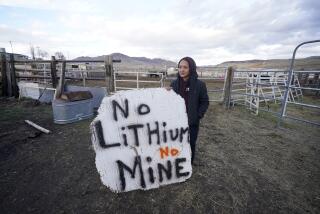Washington Dig Opens Rift With Indians
- Share via
EAST WENATCHEE, Wash. — An angry archeologist has a bone to pick about a bone not picked.
At least one rare and fragile bone tool was left in the ground at the end of a dig in an East Wenatchee apple orchard, and the director of the dig, Michael Gramly, says the controversy may be a precursor to greater Indian protests of archeological digs.
The tool perhaps best illuminates the frustration of the monthlong dig that was in some ways more a sideshow than an academic exploration.
The Colville Indians protested the dig, saying it might disturb the bones of ancestors. No remains were found, and Gramly said it was unlikely that humans from 11,200 years ago could be traced to the Colvilles.
But before it was over the dispute featured:
* Gramly wearing a bullet-proof vest while greeting a Colville medicine man through a chain-link fence.
* The plastic surgeon who owns the apple orchard and the artifacts saying he would never allow another excavation.
* Tours by 10,000 visitors, in organized groups of 30, perhaps drawn as much by the controversy as the prehistoric tools.
“I would never return to this site under the present law structure,” Gramly said as the dig concluded late last year. “I doubt any other archeologist would as well.”
But Colville tribal councilman Mathew Dick said the intrusion of Indian concerns was long overdue.
“We hope it developed an awareness among the national archeological community in regards to the Indian side of the story,” Dick said.
“Even though nobody found bones or grave-site remains, that’s not saying they were not there before,” Dick said. “We still feel it’s a grave site.”
In the face of threatened sit-ins, Gramly was forced to sign an agreement restricting excavation to areas that had already been dug and whose contents, originally thought to be 17 bone and stone tools, were known.
The abandoned tool was partially exposed just outside the permitted dig site. The tribe refused Gramly’s request for permission to remove it. He argued that the tool could be destroyed within a generation by the acidity in the soil, irrigation water and the roots of the trees.
“We believe he excavated more than we agreed to to begin with,” Dick said. “To ask us to excavate more was a little bit beyond reason.”
The tribe blames the fate of that bone tool on Gramly. “We told him to take precautions and not disturb any other tools,” Dick said.
Areas where underground radar revealed possible caches of artifacts also went unexplored.
Washington is the only state with a law regulating archeological digs on private land.
Gramly received the first permit under that new state law, and was surprised when the Indians protested just days before work was to start. The Indians claimed that they did not have sufficient time to protest.
State officials are looking to improve the process.
Historic preservation officer Jake Thomas said Gramly was not pressured by the state to restrict his dig.
Gramly said he had little choice, since part of the goal was to educate as many schoolchildren and adults as possible through tours.
“We had statements made to the press that demonstrations could not be guaranteed to remain peaceful,” Gramly complained. “It wasn’t just me who was threatened. It was visitors.”
Gramly is a curator of the Museum of Science in Buffalo, N.Y., and an expert on Clovis people. They were presumed to be the first humans to reach North America 11,000 years ago, at the end of the last ice age.
This site, discovered by orchard workers in 1987, is rare because it was largely undisturbed. More than 70 knife and spear points, scrappers and other objects have been removed.
They will be taken for two years of study and possible exhibit at the Buffalo museum.
More to Read
Sign up for Essential California
The most important California stories and recommendations in your inbox every morning.
You may occasionally receive promotional content from the Los Angeles Times.













